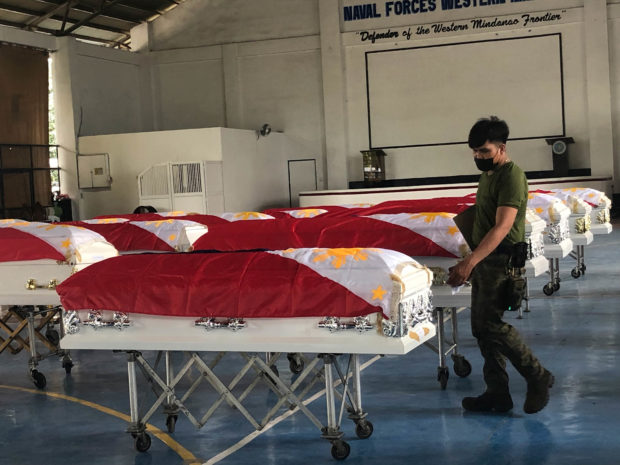
PAINFUL WAIT In these photos taken on July 9, the remains of 30 still unidentified soldiers who died in a plane crash five days earlier in Sulu, await the result of DNA matching before these are released to their respective families. On Monday, only 10 coffins are left at the Tangan gym of the Naval Forces Western Mindanao in Zamboanga City. —JULIE S. ALIPALA
ZAMBOANGA CITY, Zamboanga del Sur, Philippines — More than a month after a military plane crashed and killed 53 people in Sulu province, personnel from the police’s crime laboratory here are still completing the DNA (deoxyribonucleic acid) tests on bodies of the last group of unidentified crash victims so their remains can be returned to their families.
Thirteen coffins with Philippine flags draped around them are insideat the Tangan gym of the Naval Forces Western Mindanao compound in Barangay Lower Calarian here. They contained the bodies of the soldiers who died when the C-130 Hercules aircraft of the Philippine Air Force crashed at Sitio Amman, Barangay Bangkal in Patikul town after it overshot the Jolo runway on July 4.
Beyond recognition
“They are still unidentified,” said Police Col. Arnold Dulnuan, regional director of the regional police’s crime laboratory in Zamboanga Peninsula. “Forensic experts and DNA analysts are doing their best to secure all necessary data, including the DNA samples, so we can release all the bodies.”
The C-130 Hercules crash left 53 people — 50 of them enlisted personnel aboard the plane while three were civilians in a house hit by the burning wings of the plane — dead. Of the more than 90 people on board the aircraft, 43 survived.
Dulnuan said they immediately started gathering tissue samples on July 5, as soon as the bodies were taken to this city. He said many of the bodies were charred beyond recognition.
“Actually the first tissues we got from Sulu were immediately processed and tested, but yielded no result at all because the tissues were badly burned so we decided to get the DNA samples from their bones,” he said.
Samples were eventually drawn from the bone tissues using a reagent, but the crime laboratory faced a setback when its supply ran short.
“We have to order more reagents to continue with the extraction of tissues from the bones, so we can complete the examinations,” Dulnuan told the Inquirer.
He said DNA testing would normally take about two to three months to complete but most of the bodies recovered from the crash site had secondary identifiers like dental records, uniform patches, markings on boots, pieces of jewelry, identification cards and other “salvageable” items.
“At least, we were able to release 40 bodies to their families within a month. Three more [bodies will be released] today, so there will be only 10 bodies remaining at the gym,” Dulnuan said.
He said they wanted to send the correct bodies to the soldiers’ families. “Whatever it takes, we will make sure that they will go home to their families,” he added.

